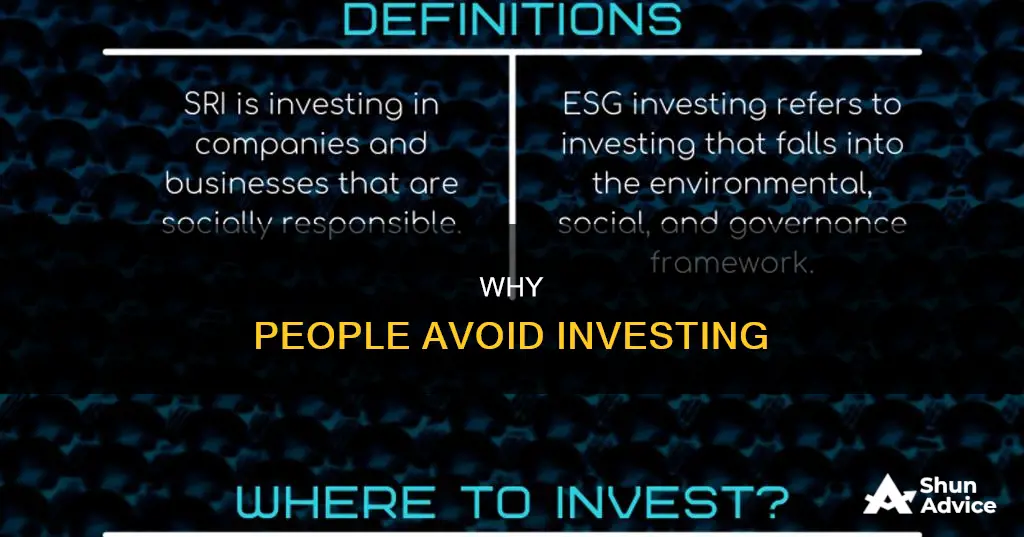
Socially responsible investing (SRI) is an increasingly popular strategy that aims to generate both social change and financial returns for an investor. However, despite its benefits, some people may be hesitant to engage in SRI due to various reasons. One common reason could be a lack of knowledge or understanding about SRI and its potential benefits. Additionally, some individuals may have a mistrust of financial markets or professionals, leading to apprehension about investing. Others may believe that they do not have enough money to invest or lack the time required for active investment strategies. Furthermore, the fear of missing out (FOMO) on immediate purchases or the perception of investment as a risky endeavour could also deter people from SRI. Lastly, the performance of SRI funds relative to the market and the alignment of personal values with specific funds are crucial considerations that may influence an individual's decision to pursue SRI.
| Characteristics | Values |
|---|---|
| Higher fees | In the past, SRI funds have been tied to higher fees than their traditional counterparts |
| Lack of energy exposure | The exclusion of fossil fuel producers or the entire energy sector may lead to underperformance |
| Lack of alignment with values | A fossil fuel-free portfolio may still hold companies that don't engage in responsible carbon emissions or pollution practices |
| Returns | SRI funds may not provide investors with a good return |
| Profitability | SRI investors are less concerned with profitability |
| Risk | SRI still comes with risks |
| Returns | Returns are not guaranteed |
| Diligence | It's important to do your homework to be sure you're investing in actually socially responsible institutions |
What You'll Learn

Fear of taking losses
The fear of losing money is a significant obstacle for most investors. This fear is valid, as people can make bad decisions, get carried away by emotions, and lose money due to situations beyond their control. However, there are ways to overcome this fear and become a successful investor.
Understanding Loss Aversion
Loss aversion is a phenomenon in behavioural economics where individuals perceive potential or real losses as psychologically or emotionally more severe than equivalent gains. The pain of losing money is often far greater than the joy of finding the same amount. This fear of loss can cause investors to behave irrationally, such as holding onto a stock for too long or too little time.
Overcoming Fear of Loss
To overcome the fear of taking losses, investors can:
- Adopt a strategic asset allocation strategy, think rationally, and not let emotions get the better of them.
- Set clear, time-bound financial goals and develop a strategy to achieve them.
- Analyze their risk tolerance and determine how much they are comfortable losing, then tailor their investment approach accordingly.
- Educate themselves about the stock market, common economic shifts, and their effects on the market.
- Start with small investments to build confidence and gradually increase investment sums.
- Choose a simple investment strategy to prevent overwhelm and mistakes.
- Focus on the long-term picture and view investing as a marathon, not a sprint.
- Be patient and persistent, learning from mistakes to minimize losses over time.
Impact of Loss Aversion on Society
Loss aversion can have unexpected impacts on society. For example, in an experiment with teachers, those who were told they would receive a bonus linked to student achievement produced significantly better results than those offered a bonus incentive.
Loss Aversion in Investing
In investing, loss aversion can lead to investors being too conservative, causing them to miss out on higher returns. It can also cause investors to sell stocks during downturns to avoid further losses, potentially missing out on gains during subsequent rallies.
SRI and Loss Aversion
When considering Socially Responsible Investing (SRI), it is essential to remember that these investments are still subject to potential losses. While SRI aims to generate positive social change and financial returns, investors must assess the financial outlook and social value of the investment.
In summary, while the fear of taking losses is a natural and valid concern, investors can take several steps to overcome this fear and make more confident, rational investment decisions.
Investing: How to Choose Wisely
You may want to see also

Lack of knowledge about investing
Understanding SRI
SRI is an investing strategy that seeks to generate positive social and environmental outcomes while also delivering financial returns. It involves aligning investments with personal values and societal impact considerations. This can be achieved through negative screening, where investors avoid companies that are not socially beneficial, and positive screening, where investors actively choose companies with positive social and environmental policies.
Challenges for Investors
A lack of knowledge can hinder investors in several ways. Firstly, it can lead to a narrow focus on well-known companies, potentially missing out on fast-rising companies with high growth potential. Investors might gravitate towards familiar names like ExxonMobil or Johnson & Johnson, but the biggest gains often come from lesser-known companies in earlier growth phases. Cisco Systems and Microsoft, for instance, offered tremendous returns for early investors.
Additionally, understanding a company's financial direction and business model requires specialised knowledge. Investors might struggle to interpret earnings calls, 10-K statements, and balance sheets without a strong financial background. This can result in suboptimal investment decisions.
Overcoming Knowledge Gaps
To address knowledge gaps, investors can utilise online resources and independent research firms' ratings to evaluate companies' social responsibility and financial prospects. Morningstar, for example, provides ratings and information on sustainable funds. Additionally, robo-advisors offer an affordable option for those seeking pre-built SRI portfolios. These algorithmic advisors construct and manage portfolios based on an investor's risk tolerance and goals.
While challenging, building an SRI portfolio can be achieved through education and the utilisation of available tools and resources. Investors should be proactive in learning about companies' social and environmental impact, as well as their financial prospects, to make informed decisions.
Forging Checks: A Risky Investment Gamble
You may want to see also

Lack of time to learn about investing
Investing is a complex and challenging skill to learn, and it can take anywhere from one to five years to fully grasp the concepts and dynamics of the stock market. For those with a busy schedule, finding the time to dedicate to learning about investing can be a significant barrier. The high volume and speed of information, the vast array of resources to sift through, and the need to understand the reactionary market can be daunting, especially for those with limited time.
Overcoming the Challenge of Time Constraints
- Prioritize learning: Recognize that investing is a valuable skill worth investing time in. Make it a priority by setting aside dedicated blocks of time for studying and researching.
- Set clear goals: Define your investment goals and objectives. Are you interested in long-term wealth accumulation, retirement planning, or funding a specific goal? Having clear goals will help you focus your learning efforts.
- Start with the basics: Begin by grasping the fundamental concepts and principles of investing. Understand the different types of investments, such as stocks, bonds, mutual funds, and exchange-traded funds (ETFs). Familiarize yourself with financial concepts like compounding, diversification, and risk management.
- Utilize efficient learning methods: Opt for structured learning programs, courses, or classes that cater to your learning style and schedule. This can include online courses, workshops, or even mentorship programs. Structured learning can help streamline the learning process and make better use of your time.
- Practice emotional control: Investing can be emotionally charged, especially when dealing with volatile markets. Practicing emotional control and maintaining a level head will help you make more rational and informed investment decisions, even when time is limited.
- Start small and build gradually: You don't need to become an expert overnight. Start with the basics and gradually build your knowledge and experience. Focus on understanding one concept at a time and applying it in a real-world investing context.
- Utilize technology: Take advantage of technology and mobile apps that provide access to market data, analysis, and investment tools. These can help streamline your research and decision-making processes, saving you time.
- Consider robo-advisors: Robo-advisors use algorithms to build and manage investment portfolios based on your goals and risk tolerance. They can be a low-maintenance way to get started with investing while you continue to learn and develop your skills.
- Find a mentor: Consider finding a mentor or joining an investment community. Mentors can provide guidance, share their experiences, and offer insights that can accelerate your learning curve.
- Make time for market observation: Dedicate time to observing and analyzing market patterns and dynamics. This will help you develop a better understanding of market behaviour and improve your decision-making abilities.
Retirement Account: Investing Beyond $5500
You may want to see also

Fear of the risk involved in investing
Fear is a powerful emotion that can significantly impact investment decisions and market psychology. The fear of losing money or making risky bets often prevents people from investing. However, it is important to understand that fear of risk is a normal emotion, and there are ways to cope with it and make informed investment choices.
Understanding Fear and Risk in Investing
Fear is a basic human emotion that can influence our decision-making, especially when it comes to money. In the context of investing, fear can manifest as a worry about losing money, uncertainty about where to start, or anxiety about market volatility. It is essential to recognise that these fears are valid and common, even for experienced investors.
Strategies to Overcome Fear of Risk
- Research and Set Goals: Educate yourself about investing strategies and set both short-term and long-term goals. Understanding different investment options and having clear objectives can make the process less overwhelming.
- Start Small: You don't need a large sum of money to start investing. Begin with a small, comfortable amount, and gradually increase your contributions as you gain confidence. Consider investing in a retirement plan, such as a 401(k) or an IRA, which offers tax advantages and, in some cases, employer matching contributions.
- Embrace Simplicity: Opt for a simple, low-stress investment strategy that you can maintain for the long term. Consider investing in a low-fee, diversified equity index fund, which diversifies risk and provides a benchmark for performance.
- Know Your Risk Tolerance: Understand your risk tolerance, which refers to the amount of risk you can comfortably take on. If you take on more risk than you can handle, you may find yourself making impulsive decisions during market downturns, such as panic selling.
- Understand Market Volatility: Recognise that market volatility is a normal part of investing. While it can be scary to see your investment value fluctuate, remember that, over time, the market has generally trended upward. Focus on staying invested through rough patches and avoid investing money you may need in the short term.
- Seek Education: Educate yourself about investing by reading books, seeking advice from certified financial planners, or consulting educational materials from reputable sources, such as your local library or securities regulators.
- Automate Your Investing: Consider automating your investments by setting up regular deductions from your paycheck or bank account. This way, you invest consistently without constantly worrying about market timing.
- Long-Term Perspective: Keep a long-term perspective in mind when investing. Historical data shows that, despite short-term fluctuations, the market has generally trended upward over time.
Final Thoughts
While fear of risk is a valid concern, it should not prevent you from investing altogether. By understanding your risk tolerance, educating yourself, and starting small, you can make informed investment decisions and work towards building wealth over time. Remember, investing is a journey, and it's okay to seek help along the way.
Startups: Invest or Avoid?
You may want to see also

Belief that they need a large income to start investing
Many people believe that they need a large income to start investing. However, this is not the case. While it is a good idea to ensure that you are managing any debt and building your savings, you can start investing today, regardless of your financial starting point.
If you only have a small amount to invest, there are apps like Stash or Acorns that allow you to start with as little as $3 a month. These apps are convenient, but they don't offer much guidance if you're new to investing. If you have $500, you can choose a robo-advisor that uses complex algorithms to build a portfolio for you. These typically have minimum deposit requirements ranging from $500 to $5,000.
If you have a larger amount to invest, you can work with a financial professional to create your portfolio. The minimum deposit will vary depending on the financial institution.
It's important to note that the minimum deposit amount is not the only cost to consider. There may also be management fees, sales commission fees, and other costs associated with the provider. Therefore, it's crucial to do your research and understand all the associated costs before deciding where to invest your money.
While you can invest any amount, how much you should invest depends on your financial situation. If you don't have enough money to cover the minimum deposit or fees, you need to plan to get there. If you have high-interest debt or haven't built up an emergency fund, addressing these issues should take precedence over investing.
- Set a budget and pay down debt: Track your spending and create a budget. If you have high-interest debt, such as credit card debt, focus on paying it off first, putting as much money towards it as you can each month.
- Build up your savings: It's important to have a cushion in case of unexpected expenses. Aim to save at least six months' worth of your household income for emergencies. If money is tight, start by setting aside a small amount automatically each month. Remember, even a small amount is better than nothing.
- Factor in goals, age, and risk tolerance: Your investment strategy should be based on your financial goals, risk tolerance, and timeline to retirement. Consider your short- and long-term goals, as well as your comfort level with risk. For example, if you're closer to retirement, you may want to take a more conservative approach.
Smart Investing for the Rest of Us
You may want to see also
Frequently asked questions
The most common reason is financial, with many people believing they don't earn enough to invest. Other reasons include a lack of trust in financial advisors, a perception of the market as too risky, and a preference for buying things in the present rather than saving for the future.
Some people view financial advisors as greedy salespeople who are more interested in their cut of the profits than their clients' success.
Investing early gives your money more time to grow. For example, if you invest $1000 at 18 years old, it could be worth $13,000 by the time you retire. Waiting until you're 30 years old to invest that same $1000 would likely result in a significantly lower return.
One misconception is that investing is too complex for non-finance professionals to understand. However, investing can be as simple as choosing a fund with a long history of positive growth, such as an S&P Index fund.







